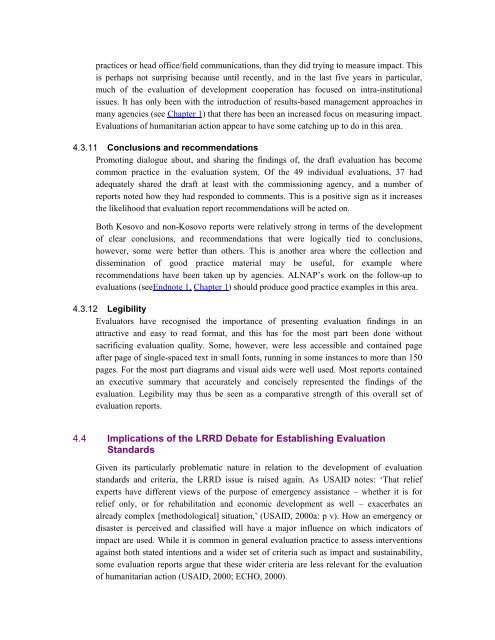Download PDF - ReliefWeb
Download PDF - ReliefWeb
Download PDF - ReliefWeb
Create successful ePaper yourself
Turn your PDF publications into a flip-book with our unique Google optimized e-Paper software.
practices or head office/field communications, than they did trying to measure impact. This<br />
is perhaps not surprising because until recently, and in the last five years in particular,<br />
much of the evaluation of development cooperation has focused on intra-institutional<br />
issues. It has only been with the introduction of results-based management approaches in<br />
many agencies (see Chapter 1) that there has been an increased focus on measuring impact.<br />
Evaluations of humanitarian action appear to have some catching up to do in this area.<br />
4.3.11 Conclusions and recommendations<br />
Promoting dialogue about, and sharing the findings of, the draft evaluation has become<br />
common practice in the evaluation system. Of the 49 individual evaluations, 37 had<br />
adequately shared the draft at least with the commissioning agency, and a number of<br />
reports noted how they had responded to comments. This is a positive sign as it increases<br />
the likelihood that evaluation report recommendations will be acted on.<br />
Both Kosovo and non-Kosovo reports were relatively strong in terms of the development<br />
of clear conclusions, and recommendations that were logically tied to conclusions,<br />
however, some were better than others. This is another area where the collection and<br />
dissemination of good practice material may be useful, for example where<br />
recommendations have been taken up by agencies. ALNAP’s work on the follow-up to<br />
evaluations (seeEndnote 1, Chapter 1) should produce good practice examples in this area.<br />
4.3.12 Legibility<br />
Evaluators have recognised the importance of presenting evaluation findings in an<br />
attractive and easy to read format, and this has for the most part been done without<br />
sacrificing evaluation quality. Some, however, were less accessible and contained page<br />
after page of single-spaced text in small fonts, running in some instances to more than 150<br />
pages. For the most part diagrams and visual aids were well used. Most reports contained<br />
an executive summary that accurately and concisely represented the findings of the<br />
evaluation. Legibility may thus be seen as a comparative strength of this overall set of<br />
evaluation reports.<br />
4.4 Implications of the LRRD Debate for Establishing Evaluation<br />
Standards<br />
Given its particularly problematic nature in relation to the development of evaluation<br />
standards and criteria, the LRRD issue is raised again. As USAID notes: ‘That relief<br />
experts have different views of the purpose of emergency assistance – whether it is for<br />
relief only, or for rehabilitation and economic development as well – exacerbates an<br />
already complex [methodological] situation,’ (USAID, 2000a: p v). How an emergency or<br />
disaster is perceived and classified will have a major influence on which indicators of<br />
impact are used. While it is common in general evaluation practice to assess interventions<br />
against both stated intentions and a wider set of criteria such as impact and sustainability,<br />
some evaluation reports argue that these wider criteria are less relevant for the evaluation<br />
of humanitarian action (USAID, 2000; ECHO, 2000).
















![CynefinFramework final [Read-Only]](https://img.yumpu.com/19017304/1/190x135/cynefinframework-final-read-only.jpg?quality=85)